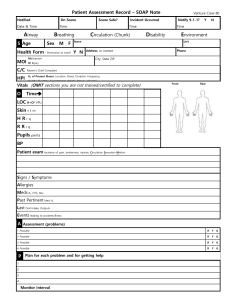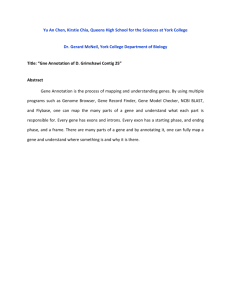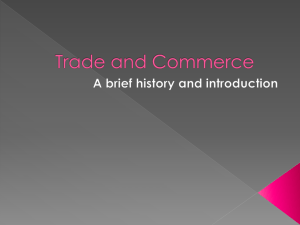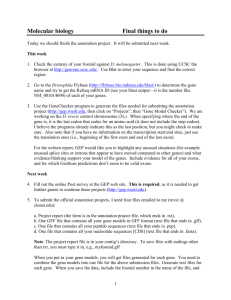GO-annotation-extensions-BioCuration-2013
advertisement
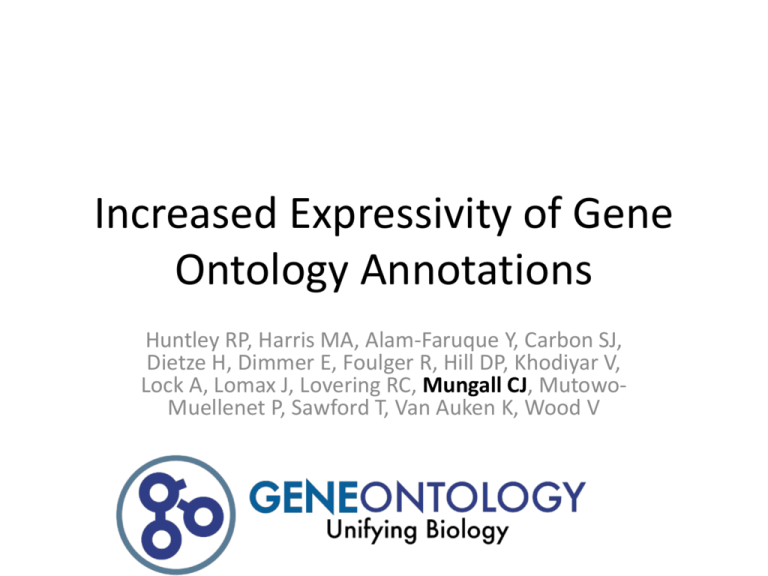
Increased Expressivity of Gene Ontology Annotations Huntley RP, Harris MA, Alam-Faruque Y, Carbon SJ, Dietze H, Dimmer E, Foulger R, Hill DP, Khodiyar V, Lock A, Lomax J, Lovering RC, Mungall CJ, MutowoMuellenet P, Sawford T, Van Auken K, Wood V The Gene Ontology • A vocabulary of 37,500* distinct, connected descriptions that can be applied to gene products gene 1 gene 2 • That’s a lot… – How big is the space of possible descriptions? *April 2013 Current descriptions miss details • Author: – LMTK1 (Aatk) can negatively control axonal outgrowth in cortical neurons by regulating Rab11A activity in a Cdk5dependent manner – http://www.ncbi.nlm.nih.gov/pubmed/22573681 • GO: – Aatk: GO:0030517 negative regulation of axon extension • GO terms will always be a subset of total set of possible descriptions – We shouldn’t attempt to make a term for everything • T63 Toxic effect of contact with venomous animals and plants Term from ICD-10, a hierarchical medical billing code system use to ‘annotate’ patient records • T63 Toxic effect of contact with venomous animals and plants – T63.611 Toxic effect of contact with Portugese Man-o-war, accidental (unintentional) • T63 Toxic effect of contact with venomous animals and plants – T63.611 Toxic effect of contact with Portugese Man-o-war, accidental (unintentional) – T63.612 Toxic effect of contact with Portugese Man-o-war, intentional self-harm • T63 Toxic effect of contact with venomous animals and plants – T63.611 Toxic effect of contact with Portugese Man-o-war, accidental (unintentional) – T63.612 Toxic effect of contact with Portugese Man-o-war, intentional self-harm – T63.613 Toxic effect of contact with Portugese Man-o-war, assault • T63 Toxic effect of contact with venomous animals and plants – T63.611 Toxic effect of contact with Portugese Man-o-war, accidental (unintentional) – T63.612 Toxic effect of contact with Portugese Man-o-war, intentional self-harm – T63.613 Toxic effect of contact with Portugese Man-o-war, assault • T63.613A Toxic effect of contact with Portugese Mano-war, assault, initial encounter • T63.613D Toxic effect of contact with Portugese Mano-war, assault, subsequent encounter • T63.613S Toxic effect of contact with Portugese Mano-war, assault, sequela Post-composition • Curators need to be able to compose their complex descriptions from simpler descriptions (terms) at the time of annotation • GO annotation extensions • Introduced with Gene Association Format (GAF) v2 – Also supported in GPAD • Has underlying OWL description-logic model http://www.geneontology.org/GO.format.gaf-2_0.shtml “Classic” annotation model • Gene Association Format (GAF) v1 – Simple pairwise model – Each gene product is associated with an (ordered) set of descriptions • Where each description == a GO term http://www.geneontology.org/GO.format.gaf-1_0.shtml GO annotation extensions • Gene Association Format (GAF) v1 – Simple pairwise model – Each gene product is associated with an (ordered) set of descriptions • Where each description == a GO term • Gene Association Format (GAF) v2 (and GPAD) – Each gene product is (still) associated with an (ordered) set of descriptions – Each description is a GO term plus zero or more relationships to other entities • Entities from GO, other ontologies, databases • Description is an OWL anonymous class expression (aka description) http://www.geneontology.org/GO.format.gaf-2_0.shtml “Classic” GO annotations are unconnected protein localization to nucleus[GO:003 4504] sty1 positive regulation of transcription from pol II promoter in response to oxidative stress[GO:0036091] pap1 cellular response to oxidative stress [GO:0034599] DB Object Term Ev Ref .. PomBase sty1 GO:0034504 IMP PMID:9585505 .. .. GO:0034599 IMP PMID:9585505 .. .. GO:0036091 IMP PMID:9585505 SPAC24B11.06c PomBase sty1 SPAC24B11.06c PomBase pap1 SPAC1783.07c .. .. Now with annotation extensions protein localization to nucleus[GO:003 4504] cellular response to oxidative stress [GO:0034599] positive regulation of transcription from pol II promoter in response to oxidative stress[GO:0036091] happens during sty1 has input <anonymous description> pap1 DB Object Term Ev Ref PomBase sty1 GO:0034504 IMP PMID:9585505 SPAC24B11.06c protein localization to nucleus pap1 GO:0036091 IMP PMID:9585505 PomBase SPAC1783.07c <anonymous description> has regulation target Extension .. happens_during(GO:0034599), has_input(SPAC1783.07c) has_reulation_target(…) .. PomBase web interface – sty1 http://www.pombase.org/spombe/result/SPAC24B11.06c pap1 http://www.pombase.org/spombe/result/SPAC1783.07c Where do I get them? • Download – http://geneontology.org/GO.downloads.annotations.shtml • MGI (22,000) • GOA Human (4,200) • PomBase (1,588) • Search and Browsing – Cross-species • AmiGO 2 – http://amigo2.berkeleybop.org - poster#57 • QuickGO (later this year) - http://www.ebi.ac.uk/QuickGO/ – MOD interfaces • PomBase – http://bombase.org Query tool support: AmiGO 2 Annotation extensions make use of other ontologies • CHEBI • CL – cell types • Uberon – metazoan anatomy • MA – mouse anatomy • EMAP – mouse anatomy • …. – http://amigo2.berkeleybop.org CL CL, Uberon – http://amigo2.berkeleybop.org CL, Uberon – http://amigo2.berkeleybop.org Curation tool support • Supported in – Protein2GO (GOA, WormBase) [poster#97] – CANTO (PomBase) [poster#110] – MGI curation tool Analysis tool support • Currently: Enrichment tools do not yet support annotation extensions – Annotation extensions can be folded into an analysis ontology - http://galaxy.berkeleybop.org • Future: Analysis tools can use extended annotations to their benefit – E.g. account for other modes of regulation in their model – Tool developers: contact us! Challenge: pre vs post composition • Curator question: do I… – Request a pre-composed term via TermGenie[*]? – Post-compose using annotation extensions? See Heiko’s TermGenie talk tomorrow & poster #33 Challenge: pre vs post composition • Curator question: do I… – Request a pre-composed term via TermGenie? – Post-compose using annotation extensions? • From a computational perspective: – It doesn’t matter, we’re using OWL – 40% of GO terms have OWL equivalence axioms protein localization to nucleus[GO:0034504] ≡ protein localization [GO:0008104] http://code.google.com/p/owltools/wiki/AnnotationExtensionFolding end_location ⊓ Nucleus [GO:0005634 ] Curation Challenges • Manual Curation – Fewer terms, but more degrees of freedom – Curator consistency • OWL constraints can help • Automated annotation – Phylogenetic propagation – Text processing and NLP Similar approaches and future directions • Post-composition has been used extensively for phenotype annotation – ZFIN [poster#95] – Phenoscape [next talk] • Future: – A more expressive model that bridges GO with pathway representations Conclusions • Description space is huge – Context is important – Not appropriate to make a term for everything – OWL allows us to mix and match pre and post composition • Number of extension annotations is growing • Annotation extensions represent untapped opportunity for tool developers Acknowledgments • GO Consortium, model organism and UniProtKB curators • GO Directors • PomBase developers: – Mark McDowell, Kim Rutherford • Funding – – – – – – GO Consortium NIH 5P41HG002273-09 UniProtKB GOA NHGRI U41HG006104-03 British Heart Foundation grant SP/07/007/23671 Kidney Research UK RP26/2008 PomBase - Wellcome Trust WT090548MA MGD NHGRI HG000330
